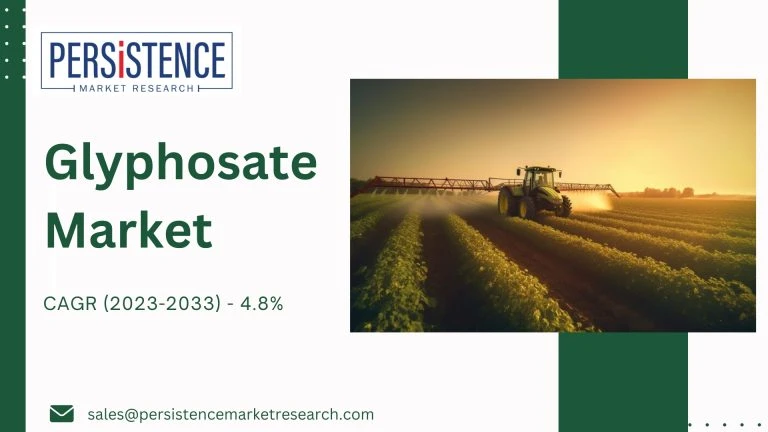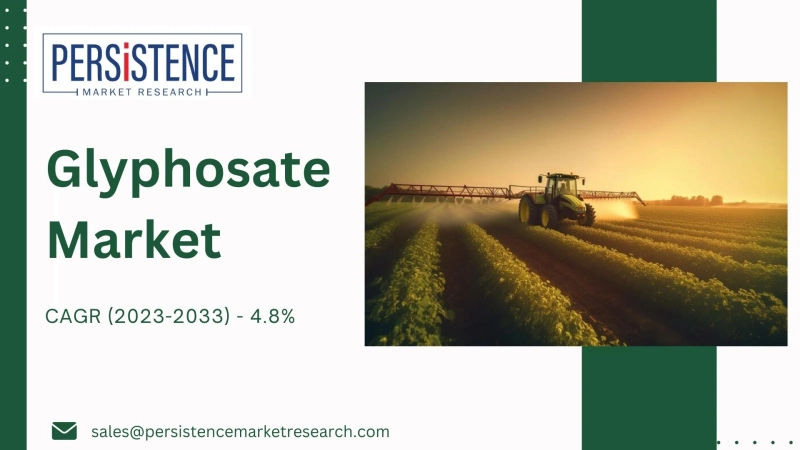
Introduction
The glyphosate market has been witnessing significant growth, driven by its extensive use in agriculture to control weeds and enhance crop yields. This article provides key insights into the glyphosate market, examining its current status, future projections, and the factors driving its growth. It also addresses the challenges posed by regulatory frameworks and health concerns.
The global glyphosate market, valued at approximately US$ 6,047.9 million in 2023, is projected to grow to US$ 8,883.3 million by 2033, reflecting a compound annual growth rate (CAGR) of 4.8% over the forecast period. Glyphosate, known chemically as N-(phosphonomethyl) glycine, is widely utilized as a broad-spectrum herbicide, particularly in agriculture for its cost-effectiveness in controlling persistent weeds across various crops like cereals, grains, fruits, and vegetables. This herbicide has significantly impacted agricultural practices globally, replacing mechanical weed control methods and contributing to enhanced crop yields. The increasing demand for glyphosate underscores its pivotal role in modern agriculture, driving steady market expansion over the next decade.
Glyphosate Market Share and Size
Market Overview
As of 2023, the global glyphosate market was valued at approximately US$ 6,047.9 million. By the end of 2033, it is expected to reach US$ 8,883.3 million, reflecting a compound annual growth rate (CAGR) of 4.8%. This steady growth underscores the increasing reliance on glyphosate for effective weed management in agricultural practices worldwide.
Historical Growth
Between 2018 and 2022, the glyphosate market saw consistent growth. Sales in 2018 were recorded at US$ 4,715.0 million, expanding at a value CAGR of 3.5% to reach US$ 6,047.9 million by 2023. This upward trend is indicative of the herbicide\'s critical role in modern agriculture.
Glyphosate Market Driven by Modern Agricultural Practices
Adoption of Modern Techniques
The adoption of modern agricultural practices has been a major driver of glyphosate market growth. Farmers are increasingly using glyphosate to improve crop yields, reduce labor costs, and manage weeds effectively. The transition towards precision farming and the use of herbicide-tolerant genetically modified (GM) crops further amplifies the demand for glyphosate.
Efficiency and Cost-Effectiveness
Glyphosate\'s efficiency and cost-effectiveness make it a preferred choice among farmers. Its ability to control a wide range of weeds with a single application reduces the need for multiple herbicides, simplifying weed management and cutting costs.
Glyphosate Market Sees Growth Despite Regulatory Challenges
Regulatory Hurdles
The glyphosate market faces significant regulatory challenges, particularly in North America and Europe. Health concerns, particularly those linking glyphosate to cancer, have led to stringent regulations and, in some cases, outright bans. These regulations aim to mitigate potential risks while ensuring the continued availability of glyphosate for agricultural use.
Balancing Benefits and Risks
Despite these challenges, the market continues to grow as regulatory bodies strive to balance the benefits of glyphosate in agriculture with its potential health and environmental risks. Ongoing research and improved formulations aim to address these concerns, ensuring safer use of glyphosate.
Glyphosate Market: Granular Glyphosate Shaping Global Trends
Product Segmentation
The global glyphosate market is segmented into liquid and granular forms. Granular glyphosate is gaining popularity due to its cost-effectiveness and ease of application. In 2023, the consumption value of granular glyphosate was estimated at US$ 182.9 million, with a steady growth rate of 4.8% CAGR.
Advantages of Granular Glyphosate
Granular glyphosate offers several advantages, including better storage stability and ease of handling. Its application is particularly beneficial in large-scale farming operations, where uniform distribution and long-lasting effects are crucial.
Glyphosate Market: Strong Demand in Europe and Asia-Pacific
European Market Dynamics
In Europe, glyphosate is extensively used in various agricultural practices to control weeds and improve crop yields. Countries like Germany, France, Italy, and Spain are key markets within the region. Despite stringent regulations, glyphosate remains a widely used herbicide due to its effectiveness and cost-efficiency.
Asia-Pacific Market Growth
The Asia-Pacific region is experiencing robust growth in the glyphosate market, driven by expanding agricultural activities. Countries such as China, India, and Australia are leading the demand due to their large-scale farming operations. Modern farming techniques and the increasing adoption of GM crops further boost glyphosate demand in the region.
Regional Market Insights
In both Europe and Asia-Pacific, glyphosate is widely used in the cultivation of cereals, grains, fruits, vegetables, pulses, and tubers. The diverse agricultural landscape and varying climatic conditions in these regions necessitate effective weed management solutions like glyphosate to ensure crop health and productivity.
Key Trends and Future Projections
Increasing GMO Crop Plantation
The rising plantation of genetically modified (GMO) crops, especially in developing regions, significantly boosts the glyphosate market. GMO crops engineered to be resistant to glyphosate allow for more extensive use of the herbicide without damaging the crops. This practice is prevalent in regions like East Asia and South Asia, where farmers aim to maximize production and profitability.
Versatile Applications
Glyphosate\'s versatile applications extend beyond agriculture. It is used in forestry, industrial weed control, lawn and garden maintenance, and aquatic environments. This broad range of applications creates numerous growth opportunities for the glyphosate market.
Competitive Landscape
The glyphosate market is highly competitive, with major players focusing on innovation, quality, and sustainability. Key companies in the market include:
- DowDuPont
- Nufarm
- BASF SE
- UPL Ltd
- HELM AG
- Bayer
- Rolfes Agri
- Wynca Group
- ADAMA Ltd
- Albaugh LLC
- GOOD HARVEST
- ENVIRO Bio Chem
These companies are investing in research and development to enhance glyphosate\'s efficacy and safety, expand production capacities, and meet the growing global demand. Strategic partnerships and collaborations further strengthen their market presence.
Future Outlook
Looking ahead, the glyphosate market is poised for steady growth. The increasing adoption of modern agricultural practices, the rising plantation of GMO crops, and the versatile applications of glyphosate will continue to drive its demand. Despite regulatory challenges and health concerns, the market\'s future looks promising with significant opportunities for innovation and expansion.
Conclusion
The glyphosate market is set to experience continued growth, driven by strong demand in Europe and Asia-Pacific. The adoption of modern agricultural practices, increasing use of GMO crops, and versatile applications contribute to this growth. While regulatory challenges and health concerns persist, ongoing research and improved formulations aim to address these issues, ensuring the safe and effective use of glyphosate in agriculture. As the agriculture industry evolves, glyphosate will remain a critical tool in enhancing crop yields and ensuring food security globally.



